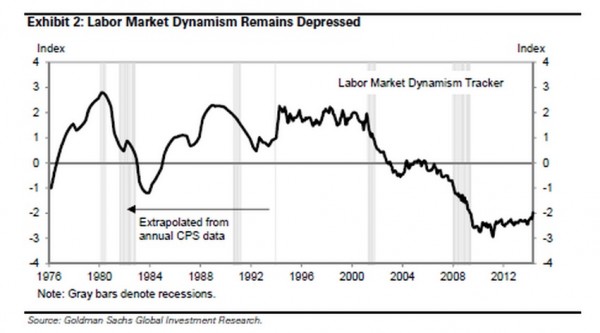Think the US job market is healthy again? Well, it isnft
— and hasnft been for a long time
James Pethokoukis
July 9, 2014, 1:31 pm - American Enterprise Institute

Itfs not enough for an economy to generate jobs. There should also be a good
amount of turnover in the labor market. Workers need to move around to find the
best fit for themselves, not to mention higher pay from taking a new gig. A
stay-put workforce is bad news.
Now net job growth is a product of total hiring minus total separations
(including layoffs and quits), as measured by the Job Openings and Labor
Turnover Survey. And as a Goldman Sachs memo points out, ga given level of net
employment growth can be achieved with a high or a low level of gross
turnover.h
So long as there is decent net growth, should we really care how it comes
about? After all, as JPMorgan point out, the 231,000 average monthly job
gains in the first half of the year was the best of any six-month period in this
expansion. Actually, we probably should care about these job market
internals. Goldman cites two reasons:
– The first is that a less dynamic labor market is likely to see weaker
wage growth as workers fail to move to jobs in which they are more productive.
Fed research suggests that the impact on aggregate productivity growth could
be considerable.
– The second reason for concern is that a low-turnover labor market risks
locking out the unemployed and marginally attached, in some cases permanently.
This ghysteresish effect is a second channel through which a lack of dynamism
can reduce potential output.
More stasis means lower wages, less productivity, and higher long-term
joblessness. So is labor market dynamism or churn declining? Goldman thinks it
is. The firm created a measure based on (a) the sum of the hiring and
separations rates in the JOLTS data; (b) the sum of the gross job gain and job
loss rates in the Business Employment Dynamics data; and (c) the share of
workers making job-to-job transitions in the monthly Current Population Survey
(CPS, also known as the household survey) micro data. Goldman finds:
c labor market dynamism has fallen substantially since 2000, with
the decline occurring during and after the last two recessions. Our
dynamism tracker has bounced back only weakly during the last two recoveries,
in contrast to the much stronger bounce-back following the recessions of the
early 1980s and 1990s.
Why the decline? There certainly may be structural reasons. Companies may be
imparting specific skills that donft easily transfer to other firms. The decline in new firms creation may also reduce worker
movement. But Goldman mostly blames weak economic growth. Insecure workers
are less likely to take a risk on a new job. As I have noted before,
it used to be common for the US economy to post a quarter of 4% or faster
real GDP growth. In the 1980s (1981-1990), there were 18 such quarters. In the
1990s (1991-2000), another 18 quarters. But in the 53 quarters since then, the
US economy has generated only six three-month periods of 4% real GDP growth or
faster, including just two during the Not-So-Great Recovery.
This is one reason Fed Chairman Janet Yellen includes
hiring and quits rates in her gdashboardh of labor market indicators. It also why the Fed should focus on growth right
now.